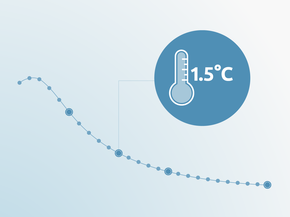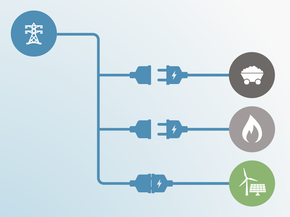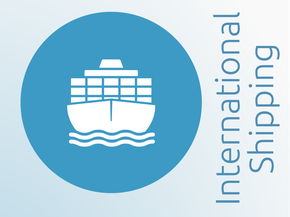Current Policy Projections
Economy-wide
With policies implemented as of September 2017, Canada will reach GHG emissions excluding LULUCF of 694–720 MtCO2e in 2020: an increase of 15–19% from 1990 levels. In 2030, emissions are projected to increase by 6–28% above 1990 levels to 637–769 MtCO2e. Some of the new policies included in the current policy projections include Alberta’s Climate Leadership Plan, British Columbia’s Clean Energy Act and Quebec’s Eco performance programme for industry.
Canada’s emissions have shown an upward trend from 1990–2007, reaching at 745 MtCO2e in 2007. At the beginning of the financial crisis of 2008/9, emissions dropped significantly. In the period from 2010–2013, emissions started to increase again but showed a short decline in 2014 and 2015. However, with currently implemented policies, emissions could either continue to decrease—or follow an upward trend—depending on GDP growth and the development of oil and natural gas prices.
In 2016, Canada published the Pan-Canadian Framework on Clean Growth and Climate Change1 to effectively combat climate change and move its economy away from fossil fuels (Government of Canada, 2016d). Of central importance in this framework is a federal backstop system or mandatory carbon pricing plan that requires all Canadian provinces and territories to either introduce a cap and trade system, or an explicit price-based system like a carbon tax or a carbon levy and performance-based emissions system by the end of 2018 (Government of Canada, 2016c). The backstopping system’s first component, a carbon levy, is applicable to fossil fuels including liquid fuels, gaseous fuels and solid fuels. The second component, an output-based pricing system, will apply to industrial facilities emitting 50 kilotonnes or more of CO2e per year (facilities in the buildings sector as well as waste and wastewater, will not be subject to the pricing system) (Powell, 2017).
Originally slated for implementation in 2018, the federal backstop carbon price will go into effect in 2019. In the fall of 2018 the proposals were assessed for compliance with the federal standard. For provinces and territories that do not adopt a carbon pricing initiative by the end of 2018 or fail to meet the benchmark, the federal backstop system will go into effect on 1 January 2019. The levy will start at of C$20/tCO2e (US$15/tCO2e) and increase by C$10 every year until it reaches C$50/tCO2e (US$38/tCO2e) in 2022 (Environment and Climate Change Canada, 2018c). It is expected that the tax will raise about C$2.3 billion in 2019 and up to C$5.6 billion by 2022-23. Proceeds will be funnelled back to the governments of participating provinces or residents (Carbon Pulse, 2018b).
In October 2018 it was announced that this system will be imposed on five of Canada’s thirteen provinces and territories, some of which have openly contested the federal government’s plan: Ontario, Manitoba, Saskatchewan, New Brunswick, and Prince Edward Island. The remote and fossil fuel dependent territories of Yukon and Nunavut will be subject to a scaled-down version of the backstopping system (Carbon Pulse, 2018b).
Carbon pricing in Canada is a positive development that could result in emission reductions. Estimates from Environment and Climate Change Canada based on a regulatory impact analysis indicate that cumulatively, 80–90 MtCO2 could be cut by 2022 when all jurisdictions have systems in place that meet the federal standard (Environment and Climate Change Canada, 2018a). Until July 2018, carbon pricing was in place in four Canadian provinces (Alberta, British Columbia, Ontario and Quebec), covering over 80% of the population (Environment and Climate Change Canada, 2018b). In July, however, Ontario’s Premier Douglas Ford repealed the province’s cap-and-trade legislation; introduced the Cap and Trade Cancellation Act outlining steps to end the programme and provide compensation for participating companies with excess allowances; and revoked the Climate Change Mitigation and Low-Carbon Economy Act of 2016, which outlines Ontario’s broader climate policy and mandate (ICAP, 2018). In response, the federal government has indicated that it will help fill the gap created by the repeal of the emissions trading system, namely the cancellation of 752 clean energy projects, with funds from the federal Low Carbon Economy Fund (Carbon Pulse, 2018c). The province is investigating how much the ending of the cap-and-trade programme will cost, including the cancellation of the C$2.9 billion sold in allowances. Manitoba’s Premier has followed suit, indicating that the province will drop its planned carbon tax of C$25/tCO2e (The Canadian Press, 2018). Ontario, Manitoba and Saskatchewan plan to file lawsuits against the federal backstop system, but experts doubt whether the provinces will succeed in their cases (Carbon Pulse, 2018a).
The 2019 Canadian price is high in comparison and becomes increasingly ambitious towards 2022. The range of carbon prices across existing initiatives globally is very broad; spanning from less than US$1/tCO2e to US$140/tCO2e with about 75% of the covered emissions priced below US$10/tCO2e (World Bank, 2017).
The Pan-Canadian Framework also proposes complementary actions to further reduce emissions across the economy and also suggests measures to build climate resilience, accelerate innovation, support clean technology and create jobs (Government of Canada, 2016d). One such measure is the Low Carbon Fund (Environment and Climate Change Canada, 2017b) which will provide C$2 billion (or approx. US$1.6 billion) to support projects that contribute to meeting Canada’s climate targets. The fund has two components: (i) C$1.4 billion will be allocated to support the leadership commitments from provinces and territories on their emission reduction priorities and the commitments they outlined in the Pan-Canadian Framework, (ii) C$0.6 billion will be available for provinces and territories, municipalities, indigenous governments and organisations, businesses and both not-for-profit as well as for-profit organisations to undertake projects that reduce Canada’s GHGs and contribute to clean growth.
A further reduction of 19% from the current policy pathway is expected from the measures listed in the Pan-Canadian Framework for the electricity sector (this includes the accelerated phase-out of traditional coal-fired plants), buildings, transport and industry sectors. The CAT estimates that under these planned policies, Canada would reach GHG emissions excluding LULUCF of 568 MtCO2e in 2030—which roughly falls in the middle between both interpretations of the NDC target. The CAT would rate the planned policies projection “Insufficient”. However, recent analysis by Energy Innovation (EI) and the Pembina Institute suggests that the gap between planned policies and the NDC target (without relying on LULUCF sinks) might even be larger than expected by the government (Energy Innovation and Pembina Institute, 2018).
Canada is also taking actions to reduce HFC emissions. In October 2016, Canada signed the Kigali Amendment to the Montreal Protocol and proposed new regulations to substantially lower HFC emissions (Government of Canada, 2016c). This is a significant move, as HFC emissions in Canada increased tenfold from 1990 to 2012.
Environment and Climate Change Canada (ECCC) prepared a strategy in 2017 to reduce Short-Lived Climate Pollutants (SLCPs) (Environment and Climate Change Canada, 2017c). This strategy aims to complement the actions outlined in the Pan-Canadian Framework for SLCPs mitigation. Canada’s revised NDC also mentions that Canada is taking actions to reduce SCLPs as they contribute locally to Arctic warming. The strategy by ECCC includes enhanced domestic mitigation and scientific work, engagement with the international community, improved coordination between ECCC and the Canadian Government’s activities on the subject as well as collaboration with provincial and territorial governments.
1 | The province of Saskatchewan has not adopted the Framework; provinces have the flexibility to design their own plans to meet their emission reduction targets.
Energy supply
A stringent performance standard for new coal-fired power plants came into force on 1 July 2015, limiting emissions intensity to 420 tCO2/GWh. The standard also applies to plants that have reached their useful end of life. In general, this means ageing, ~50-year old units - the first of the currently operating power plants commissioned before 1975 - will reach the end of their useful life after 2020 and will therefore not be subject to the performance standard until then. Given this age profile, and the current poor investment environment for new coal power, the performance standard will not contribute to any significant emissions reduction below business as usual by 2020.
In November 2016, Canada announced it would amend its existing coal-fired electricity regulation and accelerate the phase out of traditional2 coal-fired power plants by 2030 (Government of Canada, 2016e). Since the phase-out may pose challenges for some provinces, the government has indicated that it is willing to negotiate the terms with the provinces still generating electricity using coal: Alberta, Saskatchewan, Nova Scotia and New Brunswick.
In fall 2017, Canada co-founded the Powering Past Coal Alliance to help accelerate clean growth and climate protection through the rapid phase-out of traditional coal-fired electricity (Government of Canada, 2018b). In February 2018 the Minister of Environment and Climate Change announced amendments to existing regulations to phase out traditional coal-fired electricity in Canada by 2030 as well as new greenhouse gas regulations for natural-gas-fired electricity (Environment and Climate Change Canada, 2018e). Such developments are critical because to reach full decarbonisation globally, no new coal plants should be built, and emissions from coal power should be reduced by two-thirds between 2020–2030.
Despite this phase-out of traditional coal-fired power plants, other developments in Canada suggest that this does not imply a total phase out of all coal-fired power plants. Saskatchewan’s Boundary Dam CCS project is the world’s first and largest commercial-scale coal-fired CCS project. It has the nominal capacity to capture 90% of its GHG emissions, which amounts to around 1 MtCO2eq/year (Government of Canada, 2016b). While some of the CO2 will be stored directly, most of it will be used for enhanced oil recovery which means it will also not be emitted back into the atmosphere (Global CCS Institute, 2016). The CCS unit has captured almost 1.5 million tonnes of CO2 between the start of its operation in October 2014 and March 2017 (Global CCS Institute, 2016). The project cost a total of C$1.5 billion, including C$240 million in government funding (MIT CC&ST, 2016). Canada budgeted C$1 billion in 2016 and made a commitment of C$2.37 billion in 2017 over four years for clean technology industry. The government also announced an additional C$21.9 billion over 11 years for green infrastructure (David Suzuki Foundation, 2017).
Canada reaffirmed its commitment to reduce methane emissions from the oil and gas sector by 40–45% from 2012 levels by 2025 as part of the Pan-Canadian Framework on Clean Growth and Climate Change and in April 2018, Environment and Climate Change Canada (ECCC) published federal methane regulations (Environment and Climate Change Canada, 2018d). It is estimated that these regulations, which include general requirements for compressors and well completions involving fracking and conditional requirements for other technologies, will result in cumulative GHG emission reductions of 232 MtCO2e between 2018 and 2035 (Powell, 2018). In the same week, Alberta Energy Regulator (AER) issued its own regulations using a performance-based approach. Unless it can be demonstrated that Alberta’s regulations are equivalent to those at the federal level, the federal regulations will apply.
Canada’s oil reserves, in particular oil sands, 97% of which are located in the province of Alberta, contribute to Canada’s role as a global energy supplier (EIA, 2015). Reserves of oil sands in Alberta total about 165.4 billion Barrels (bbl), the extraction of which has been contentious and opposed by environmental and indigenous groups. Despite fierce opposition, the Canadian government purchased the Trans Mountain pipeline in May 2018, facilitating the transport of Alberta’s oil to a port in the Vancouver area and sale to Asia and the United States (Leyland, 2018).
Carbon Capture and Storage (CCS) is used in a number of energy industries including oil sands development to reduce CO2 emissions. Alberta is investing C$1.24 billion (US$ 934 million)over 15 years in two large scale CCS projects, the Alberta Carbon Trunk Line and the Quest Project (Alberta Energy, 2018). We note that the National Energy Board (NEB) published energy supply and demand projections to 2040, including a breakdown of electricity generation that differs from that of the Seventh National Communication (National Energy Board of Canada, 2017). While the NEB electricity generation projections include noteworthy deviations from the projections upon which our assessment is based (e.g. 22 TWh more from coal and coke and 70 TWh less from natural gas in 2030), we have not modelled them as a separate emissions pathway as the resulting emissions fall within that of the existing current policies pathway.
In the spring of 2018, the IEA published a report “Energy Efficiency Potential in Canada to 2050” that was drafted in cooperation with Canadian stakeholders (IEA, 2018). The report describes how final energy savings of 1.9% annually on average can be achieved through 2050 with current policies and feasible energy efficiency investments and measures. The authors conclude that an 96 PJ of energy savings would result from an additional USD 1 billion invested in energy efficiency and that energy-related CO₂ emissions could decline by 30% by 2050.
2 | Traditional coal-fired electricity does not use carbon capture and storage (CCS) to capture carbon dioxide and store it.
Industry
In July 2018, Canada amended its carbon pricing backstop plan for the industry sector, which was originally proposed in January 2018. The change aims to reduce the impact of the carbon tax on heavy industry by increasing subsidies on production and thereby reducing the competitive risk of certain industries (Dawson & Thomson, 2018). It was originally proposed in January 2018 that companies will be taxed if they emit more than the 70% of the benchmark for average emissions but in the summer the benchmark was increased to 80%, essentially allowing companies to emit more without being taxed. For heavy industries, such as cement, iron & steel manufacturing, and lime and nitrogen fertilisers, the threshold increases to 90% of their average industrial emissions (Connolly, 2018).
Transport
In November 2016, the Canadian government also announced that it will develop clean fuel standards, in consultation with provincial and territorial governments, to reduce emissions from fuels used in transportation, buildings and industry (Government of Canada, 2016c). Final regulations for liquid fuels are to be published in 2020 and final regulations for gaseous and solid fuel streams are the be published in 2021 (Government of Canada, 2018a). Canada has various policies in place to reduce emissions from the transport sector. Fuel economy standards for light and heavy-duty vehicles are aligned with federal-level regulations in the US. Canada has also implemented a regulation requiring a renewable fuel content of 2% for diesel and 5% for gasoline. Released in 2018, Canada established more stringent greenhouse gas emission standards beginning with the 2021 model year for on-road heavy-duty vehicles and engines as well as new emission standards applicable to trailers hauled by on-road transport tractors for which the manufacture is completed on or after 1 January 2020 (Government of Canada, 2018c).
In August 2018, the Canadian Government began consultations on the mid-term evaluation of Canada's 2014 light-duty vehicle GHG emission regulations for the 2022–2025 model years (Markets Insider, 2018). The consultation will address issues such as cost savings, the cost of compliance, the competitiveness of the Canadian auto industry, and Canada's commitments under the Paris Agreement and the Pan-Canadian Framework on Clean Growth and Climate
Because Ontario cancelled its cap-and-trade programme on 11 July 2018, the province’s Electric and Hydrogen Vehicle Incentive Program was cancelled and incentives are winding down (Ontario Ministry of Transportation, 2018). To reach full decarbonisation of the road transport sector worldwide, the last fossil fuel car should be sold before 2035.
Forestry
Canada’s forests cover more land area and store more carbon than the forests of almost any other country. Managed forests in Canada total approximately 226 million hectares or 65% of Canada’s total forest area, this includes all forests under direct human influence and including forests managed for harvesting, forests subject to fire or insect management, and protected forests, like those found in national and provincial parks. (Natural Resources Canada, 2018a). Net emissions totalled 78 MtCO2e in 2016, which is the result of 20 MtCO2e of removals from human activities and 98 MtCO2e of emissions from large-scale natural disturbances such as from fires. In 2017 5,611 forest fires resulted in 3.4 million hectares being burned, almost 1 million hectares more than in an average year (Natural Resources Canada, 2018b)
Further analysis
Latest publications
Stay informed
Subscribe to our newsletter






